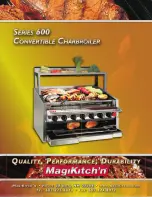
122
Mounting the burner door correctly back onto the heat exchanger:
IMPORTANT:
Before mounting the burner door, make sure that its gaskets and insulation are in excellent shape.
If any signs of damage or ageing are present, these parts must be replaced.
The burner door must be mounted back on the heat exchanger as follows, see picture below:
- Place the burner door with its holes over the six threaded studs, numbered 1 to 6 in the picture.
Careful! When handling too rough or misplacing the holes over the threaded studs, the burner door insulation and/or
gaskets may be damaged.
Assure yourself that the door is well positioned with respect to the threaded studs, before
pushing it onto the exchanger.
-
Now keep the burner door in place and first turn one flange nut onto stud 1 so the door won’t fall. After that, first
mount the other end of the gas/air mixing pipe to the non-return valve, starting at point
I
, and make sure it’s well
tightened.
- Now keep the burner door firmly in place by pushing the gas/air nose with one hand at the middle at point A.
- Then turn-tighten the flange nuts with the other hand as far as possible onto the threaded studs.
Now the burner door is in place and the nuts can be tightened with a torque key.
-
Tighten the nuts in the order given in the picture below
-
The specified torque value for tightening the burner door flange nuts is 8 Nm
tighten in given order.
torque value = 8 Nm
Non-return valve
Remove the non-return valve from the fan by loosening the nuts and remove the wiring by disconnecting the con-
nector. Check if there is any moist or any traces of moist on the fan side of the valve. This can indicate that there is
a possible leakage of the non-return valve (danger of recirculation).
Check always
if the rubber seat on which the valve closes isn’t damaged or if there is any debris on this seat, if so
clean or replace the seat. Also chec
k if the valve itself isn’t jammed
and can move freely up and down and if the
magnet pulls the valve into its seat, if not so replace the complete non-return valve.
Fan
When the fan blades are polluted and dirty, carefully clean the blades with a soft brush. Notice: do not use too much
force on the blades or else the fan might be out of balance and run irregularly, causing noises and fan failures. Check
the fan also for any water damages. In doubt always replace the fan of the boiler.
Insulation
The insulation of the heat exchanger (located on the rear wall inside the heat exchanger and burner door) must be
inspected. If this insulation disk shows any signs of (water) damage or degradation it should be exchanged. Also
check if there are any indications in the burner room of a high condensate level (caused by a blocked siphon) that
might have wetted the rear wall insulation. When this has happened the rear wall insulation should also be replaced.
Only use the insulation disk that is supplied by the boiler manufacturer.
The same procedure must be applied on the insulation and gaskets fitted on the burner door.
A
1
3
5
2
4
6
I
III
IV
II







































